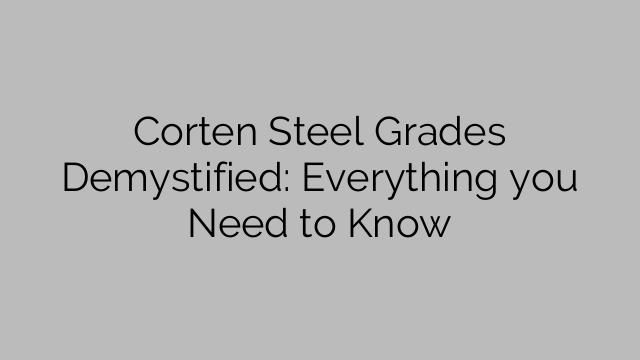Corten steel, also known as weathering steel, is a group of steel alloys that were developed to eliminate the need for painting and extend the lifespan of structures in harsh weather conditions. The key feature of Corten steel is its ability to form a stable rust-like appearance, which not only adds a distinctive visual appeal but also acts as a protective barrier against corrosion.
There are several different grades of Corten steel available, each with its own unique properties and characteristics. The most common grades of Corten steel are Corten A and Corten B, which are often used in architectural applications. These grades differ mainly in their composition, with Corten A containing a higher percentage of copper, while Corten B contains less copper.
Corten A is known for its excellent atmospheric corrosion resistance and is often used in outdoor sculptures, architectural cladding, and building facades. Its composition allows it to form a stable rust-like appearance quickly, providing a protective coating that prevents further corrosion.
On the other hand, Corten B offers similar atmospheric corrosion resistance to Corten A but has additional features that make it ideal for heavy-duty structural applications. It is specifically designed for high-stress environments, such as bridges, pylons, and other structural frameworks.
Apart from Corten A and Corten B, there are other less commonly used grades of Corten steel available. These include Corten IRSM 41-97 and Corten M, which are mainly used in railway applications and construction projects requiring high tensile strength.
Corten IRSM 41-97 is a specially formulated grade of Corten steel that offers improved weather resistance compared to standard Corten steel. It is often used in railway wagons, containers, and structural applications in coastal areas where corrosion is more severe.
Corten M is a relatively new grade of Corten steel specifically developed for facade cladding applications. It offers superior corrosion resistance, making it suitable for buildings located in highly polluted and urban environments.
When selecting the appropriate grade of Corten steel for your project, it is crucial to consider the specific environmental conditions and the desired aesthetic outcome. Some grades may be more suitable for harsh conditions, while others may be favorable for their unique visual appeal.
It is also important to note that Corten steel requires regular maintenance and should be periodically inspected and cleaned to remove any debris or dirt that may trap moisture and interfere with the protective patina formation.
In conclusion, Corten steel is a versatile and durable material that can withstand harsh weather conditions while adding a unique aesthetic appeal to any structure. Understanding the different grades of Corten steel and their specific properties will help you make an informed decision when choosing the right material for your project. Whether you are looking for a weather-resistant cladding solution or a heavy-duty structural framework, there is a Corten steel grade suitable for your needs.
[ad_2]

